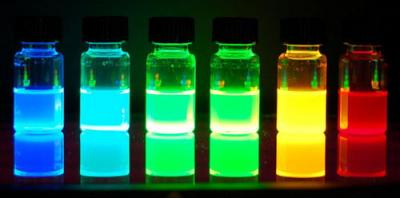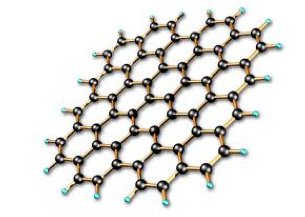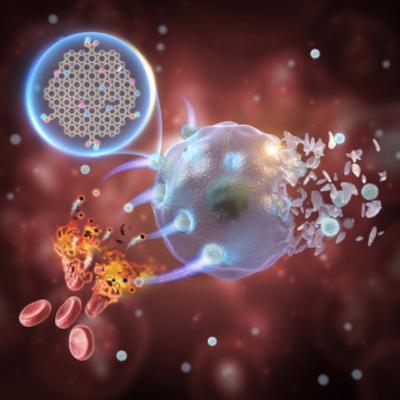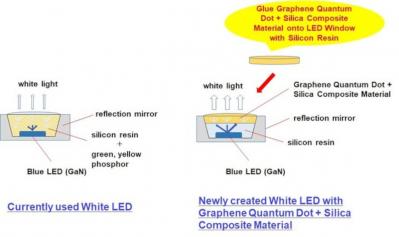Graphene Quantum Dots: Introduction and Market News
What are quantum dots?
Quantum dots, or QDs, are semiconductor nanoparticles or nanocrystals, usually in the range of 2-10 nanometers (10-50 atoms) in size. Their small size and high surface-to-volume ratio affects their optical and electronic properties and makes them different from larger particles made of the same materials. Quantum dots confine the motion of conduction band electrons, valence band holes, or excitons (bound pairs of conduction band electrons and valence band holes) in all three spatial directions. Quantum dots are also sometimes referred to as ‘artificial atoms’, a term that emphasizes that they are a single object with bound, discrete electronic states, similarly to naturally occurring atoms or molecules.

Many types of quantum dot are fluorescent - they emit light of specific frequencies if electricity or light is applied to them. These frequencies can be tuned by changing the dots' size, shape and material, opening the door to diverse applications. Generally speaking, smaller dots appear blue while larger ones tend to be more red. Specific colors also vary depending on the exact composition of the QD.
Applications
Thanks to their highly tunable properties, QDs are attracting interest from various application developers and researchers. Among these potential applications are displays, transistors, solar cells, diode lasers, quantum computing, and medical imaging. Additionally, their small size enables QDs to be suspended in solution, which leads to possible uses in inkjet printing and spin-coating. These processing techniques may result in less-expensive and less time consuming methods of semiconductor fabrication.
Quantum dots are considered especially suitable for optical applications, thanks to their ability to emit diverse colors, coupled with their high efficiencies, longer lifetimes and high extinction coefficient. Their small size also means that electrons do not have to travel as far as with larger particles, thus electronic devices can operate faster. Examples of applications that take advantage of these electronic properties include transistors, solar cells, quantum computing, and more. QDs can greatly improve LED screens, offering them higher peak brightness, better colour accuracy, higher color saturation and more.
QDs are also very interesting for use in biomedical applications, since their small size allows them to travel in the body, thus making them suitable for applications like medical imaging, biosensors, etc.
What is graphene?
Graphene is a material made of carbon atoms that are bonded together in a repeating pattern of hexagons. Graphene is so thin that it is considered two dimensional. Graphene's flat honeycomb pattern gives it many extraordinary characteristics, such as being the strongest material in the world, as well as one of the lightest, most conductive and transparent. Graphene has endless potential applications, in almost every industry (like electronics, medicine, aviation and much more).

The single layers of carbon atoms provide the basis for many other materials. Graphite, like the substance found in pencil lead, is formed by stacked graphene. Carbon nanotubes are made of rolled graphene and are used in many emerging applications from sports gear to biomedicine.
Graphene quantum dots
The term graphene quantum dots (GQDs) is usually used to describe miniscule fragments, limited in size, or domains, of single-layer to tens of layers of graphene. GQDs often possess properties like low toxicity, stable photoluminescence, chemical stability and pronounced quantum confinement effect, which make them attractive for biological, opto-electronics, energy and environmental applications.
The synthesis of graphene quantum structures, such as graphene quantum dots, has become a popular topic in recent years. While graphene usually does not have a bandgap - which is a problem for many applications - graphene quantum dots do contain a bandgap due to quantum confinement and edge effects, and that bandgap modifies graphene's carrier behaviors and can lead to versatile applications in optoelectronics. GQDs were also found to have four quantum states at a given energy level, unlike semiconductor quantum dots, which have only two. These additional quantum states, according to researchers, could make GQDs beneficial for quantum computing.
Additional properties of GQDs such as high transparency and high surface area have been proposed for energy and display applications. Because of the large surface area, electrodes using GQDs are applied for capacitors and batteries.
Various techniques have been developed to produce GQDs. Top-down methods include solution chemical, microwave, and ultrasonic methods. Bottom-up methods include hydrothermal and electrochemical methods.
Further reading
- Introduction to graphene
- Graphene Oxide
- Graphene Inks
- The Graphene Handbook, our very own guide to the graphene market
Researchers design graphene quantum dots for cancer treatment
Researchers at China's Hunan University, Chinese Academy of Sciences and the University of Washington in the U.S have developed a metal-free nanozyme based on graphene quantum dots (GQDs) for highly efficient tumor chemodynamic therapy (CDT).
GQDs have potential as a cost-effective means of addressing the toxicity concerns associated with metal-based nanozymes in tumor CDT. However, the limited catalytic activity of GQDs has posed significant challenges for their clinical application, particularly under challenging catalytic conditions. "The obtained GQDs, which are made from red blood cell membranes, are highly effective in treating tumors with few side effects," said Liu Hongji, a member of the research team. "One of the advantages is that they are metal-free. In addition, they function as excellent peroxidase-like biocatalysts."
Researchers design semitransparent image sensors for eye-tracking applications using graphene and QDs
A team of researchers from The Barcelona Institute of Science and Technology (ICFO) and Barcelona-based startup Qurv Technologies have designed flexible, nearly transparent graphene-enhanced image sensors that could be hidden in plain sight.
The sensors, based on graphene and quantum dots, could be integrated directly onto eyeglasses or curved windshields, placed right in front of a user’s eyes. This could make eye-tracking hardware less bulky, improve the accuracy of gaze detection, and reduce computational complexity, says Frank Koppens, who co-led the research and co-founded Qurv in 2020.
Researchers create symmetric graphene quantum dots for future qubits
Researchers from Germany's RWTH Aachen University, Forschungszentrum Jülich and Japan's National Institute for Materials Science (NIMS) have found that bilayer graphene allows the realization of electron–hole double quantum dots that exhibit near-perfect particle–hole symmetry. Moreover, They showed that particle–hole symmetric spin and valley textures lead to a protected single-particle spin-valley blockade that will allow robust spin-to-charge and valley-to-charge conversion, which are essential for the operation of spin and valley qubits.
Quantum dots in semiconductors such as silicon or gallium arsenide are considered great candidates for hosting quantum bits in future quantum processors. The recent study essentially shows that bilayer graphene has even more to offer than other materials. The double quantum dots the researchers have created are characterized by a nearly perfect electron-hole-symmetry that allows a robust read-out mechanism – one of the necessary criteria for quantum computing.
Graphene quantum dots could improve magnetic field sensors
Researchers from the University of California Santa Cruz, University of Manchester and Japan's International Center for Materials Nanoarchitectonics and National Institute for Materials Science have used a scanning tunnelling microscope to create and probe single and coupled electrostatically defined graphene quantum dots, to investigate the magnetic-field responses of artificial relativistic nanostructures.
Trapped electrons traveling in circular loops at extreme speeds inside graphene quantum dots are highly sensitive to external magnetic fields and could be used as novel magnetic field sensors with unique capabilities. Although graphene electrons do not move at the speed of light, they exhibit the same energy-momentum relationship as photons and can be described as "ultra-relativistic." When these electrons are confined in a quantum dot, they travel at high velocity in circular loops around the edge of the dot.
Graphjet Technology partners with Quantum Science to explore graphene-based materials device platform
Malaysia-based graphite and single-layer graphene producer, Graphjet Technology (GTI), has partnered with Quantum Science (QS), a UK-based quantum dot and ink technology developer, to explore technical and commercial opportunities to develop a quantum dot and graphene-based materials device platform.
GTI, which is on its way to a listing on the Nasdaq Exchange following the merger with SPAC Energem Corp, will be responsible for the funding of the development of the platform. At the same time, QS is responsible for developing the platform. GTI expects to contribute up to five million pounds (over USD$5.7 million) towards the platform's development during the deal's term or around three years.
Researchers show that graphene quantum dots can block SARS-CoV-2 Variant from entering cells
A recent study has reported the use of human host defense peptide-conjugated graphene quantum dots for the prevention of virus entry into host cells.
Research on the SARS-CoV-2 virus mainly focuses on the spike protein (S1) which contains the receptor-binding domain (RBD) and the binding of this to the angiotensin converting enzyme 2 (ACE2) receptor within epithelial cells enables the virus to enter host cells in humans. This research resulted in the spike protein becoming a target for vaccines that aimed to produce neutralizing antibodies against the S-RBD. But while this concept seemed useful, recent reports have suggested the mutations on the SARS-CoV-2 virus and specifically in the S-RBD, can cause a decline in the level of neutralizing antibodies against the delta (B.1.617.2) variant that may have been produced during a previous infection or from immunization via a vaccine.
New strategy uses graphene quantum dots to boost catalysts
Rice University researchers, in collaboration with teams at Oak Ridge National Laboratory, University of Saskatchewan, King Abdullah University of Science and Technology and CAS, have used graphene quantum dots (GQDs) to assemble what they say may transform chemical catalysis by greatly increasing the number of transition-metal single atoms that can be placed into a carbon carrier.
 The process uses functionalized graphene quantum dots to trap transition metals for higher metal loading single-atom catalysis. Illustration courtesy of the Wang Group (from Rice Uni website)
The process uses functionalized graphene quantum dots to trap transition metals for higher metal loading single-atom catalysis. Illustration courtesy of the Wang Group (from Rice Uni website)
The technique uses graphene quantum dots, 3-5-nanometer particles of graphene, as anchoring supports. These facilitate high-density transition-metal single atoms with enough space between the atoms to avoid clumping.
Qurv Technologies develops graphene-enabled wide-spectrum image sensor technologies
Qurv Technologies, a Spain-based startup established in 2020 to develop wide-spectrum image sensors based on graphene and quantum-dot technologies, has developed a sensor that combines the unique electronic properties of graphene with suitable quantum nanoparticles as light sensitizers. The new device reportedly enables efficient detection of a broad range of wavelengths from ultraviolet to infrared light all concentrated into one simple device.
The production and transfer process of graphene leverages existing scalable Complementary Metal Oxide Semiconductor (CMOS) manufacturing processes. Furthermore, this graphene-based sensor could replace traditional costly alternatives based on indium gallium arsenide, paving the way to SWIR imagers up to 1000 times cheaper.
GS Alliance develops a graphene QD and silica composite to create efficient white LEDs
Japan-based material developer Green Science Alliance developed a new composite material made from a combination of graphene quantum dots and silica, which could be useful for creating white LEDs from blue LEDs (440-470 nm).
The company says that this is the first adoption of such a material for LED applications. The company says the adoption of the QD and Silica offers superior performance to the currently-used phosphor as the QDs do not suffer from light scattering, and the white LED is more efficient. The material is also said to be inexpensive.
ZEN Graphene Solutions and NPNL jointly receive NSERC grant
 ZEN Graphene Solutions, in partnership with Professor Mohammad Arjmand, has announced the award of a CAD$780,000 (around USD$609,600) Alliance Grant - part from the Natural Sciences and Engineering Research Council of Canada (NSERC) and the rest from a combination of cash and in kind contributions from ZEN).
ZEN Graphene Solutions, in partnership with Professor Mohammad Arjmand, has announced the award of a CAD$780,000 (around USD$609,600) Alliance Grant - part from the Natural Sciences and Engineering Research Council of Canada (NSERC) and the rest from a combination of cash and in kind contributions from ZEN).
Alliance Grants are awarded through a competitive peer review process, and this proposal, titled Synthesis of Graphene Nanomaterials and Development of Their Multifunctional Polymer Nanocomposites, is ZEN’s highest single monetary grant award from NSERC to date and supports NSERC’s growing interest in nanomaterials.
Pagination
- Page 1
- Next page





